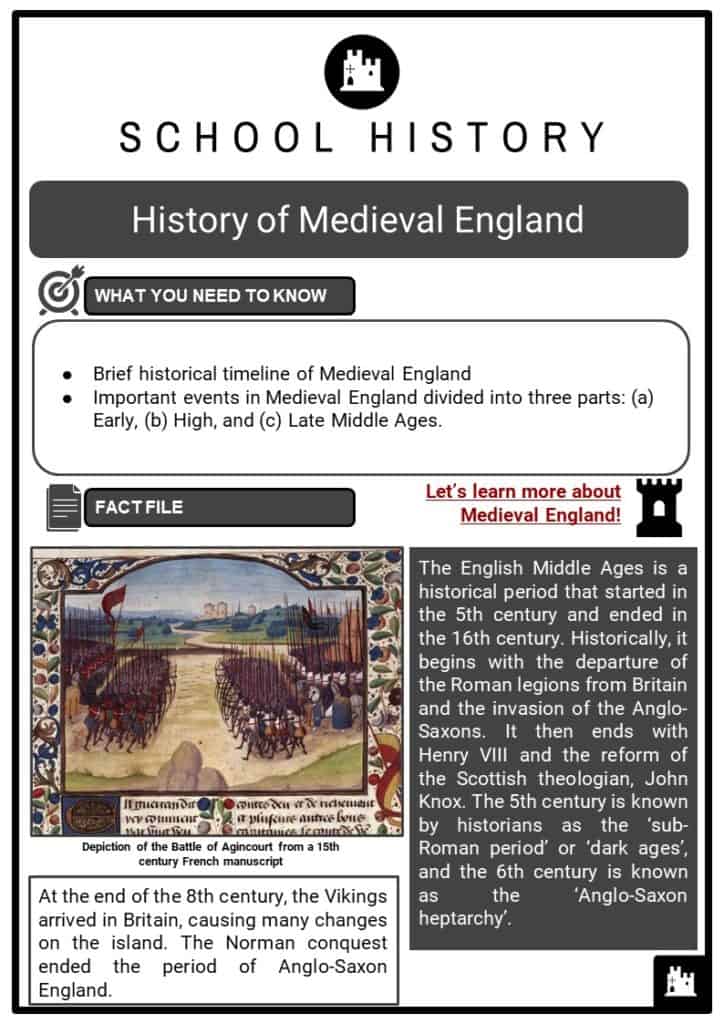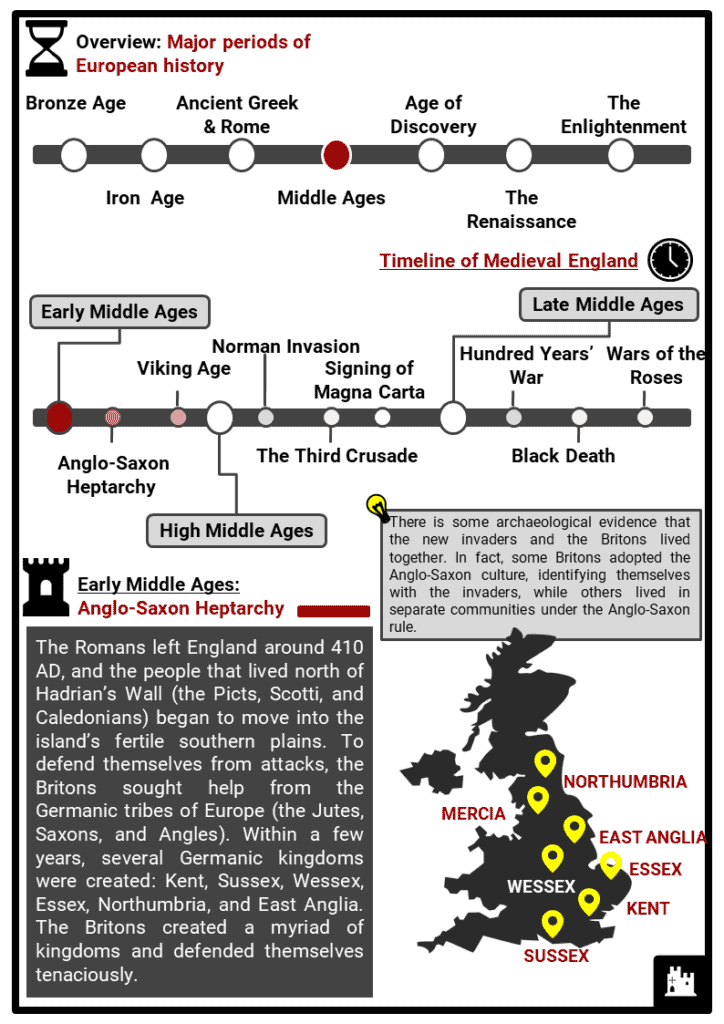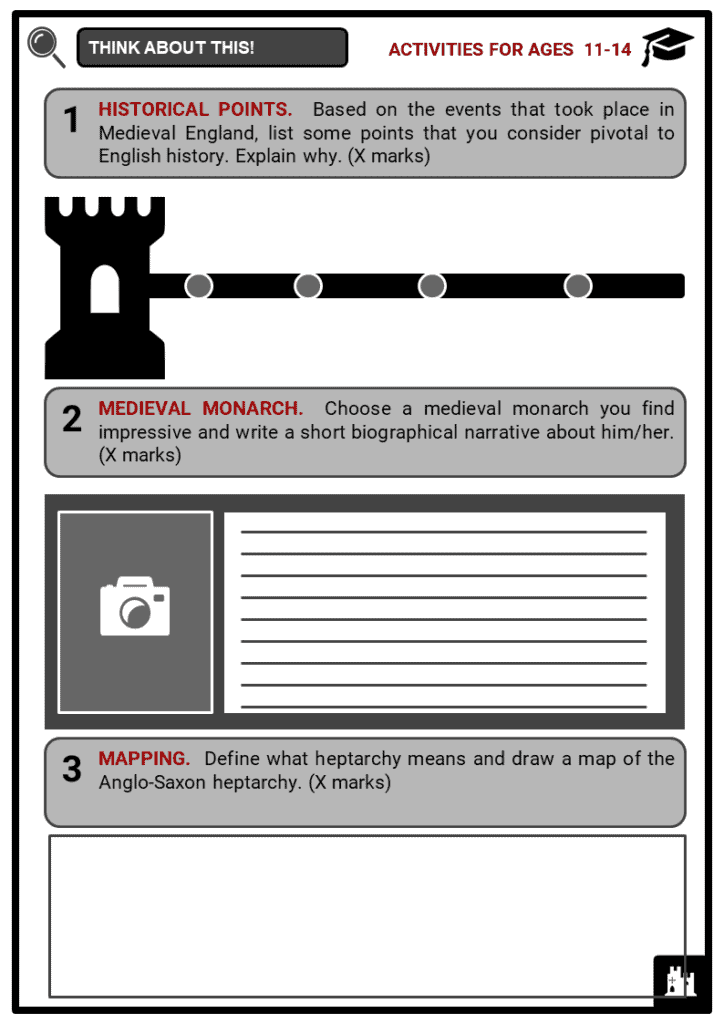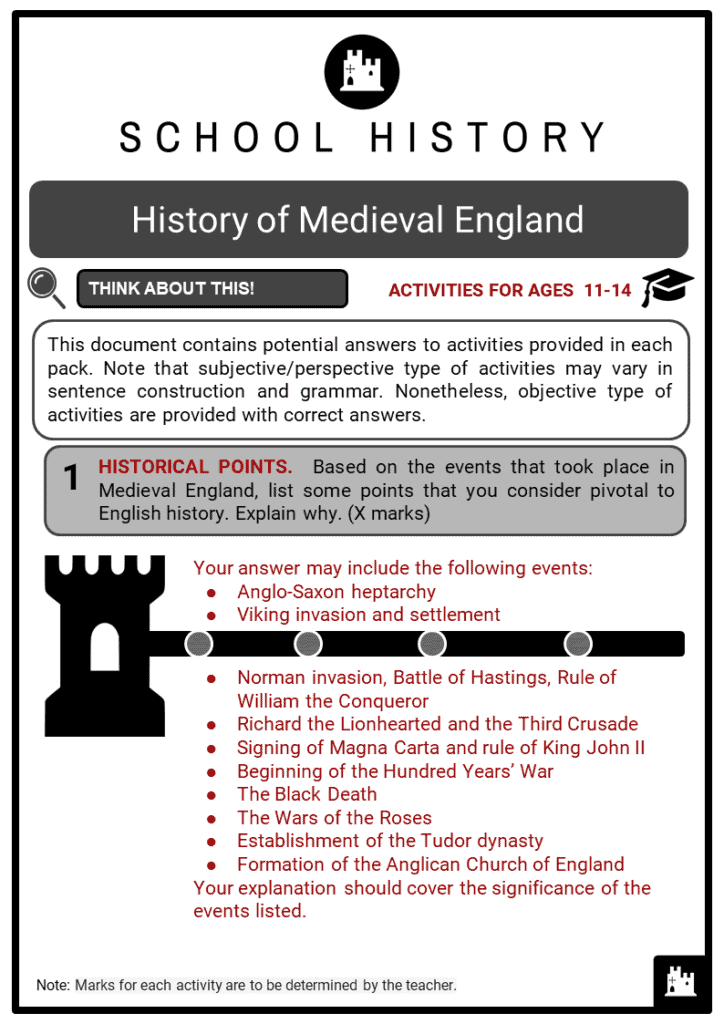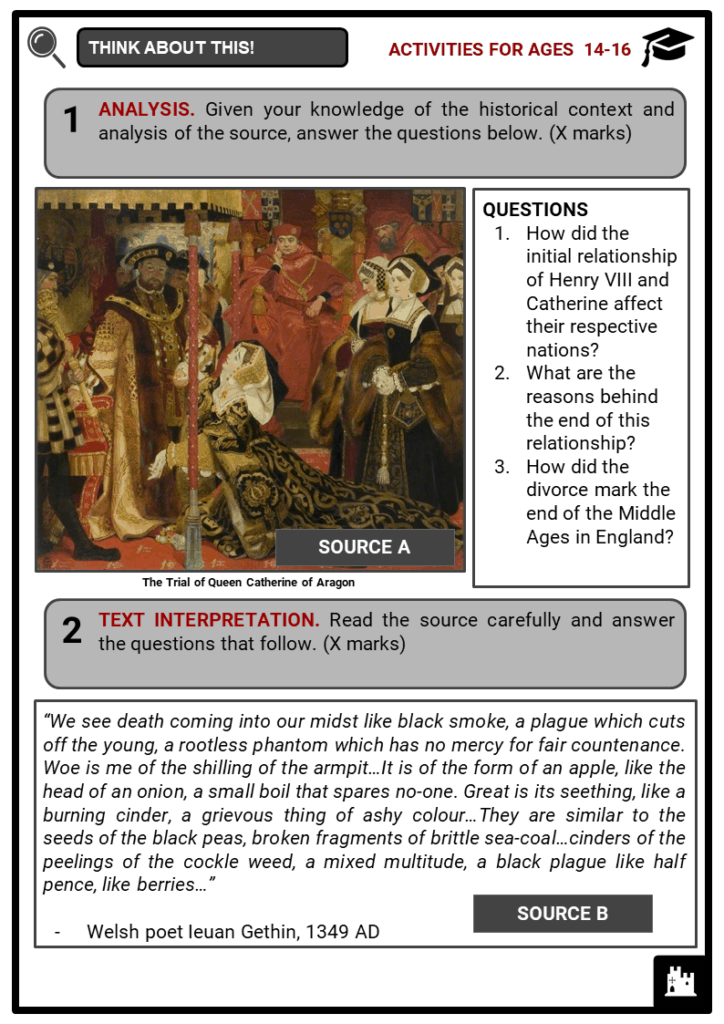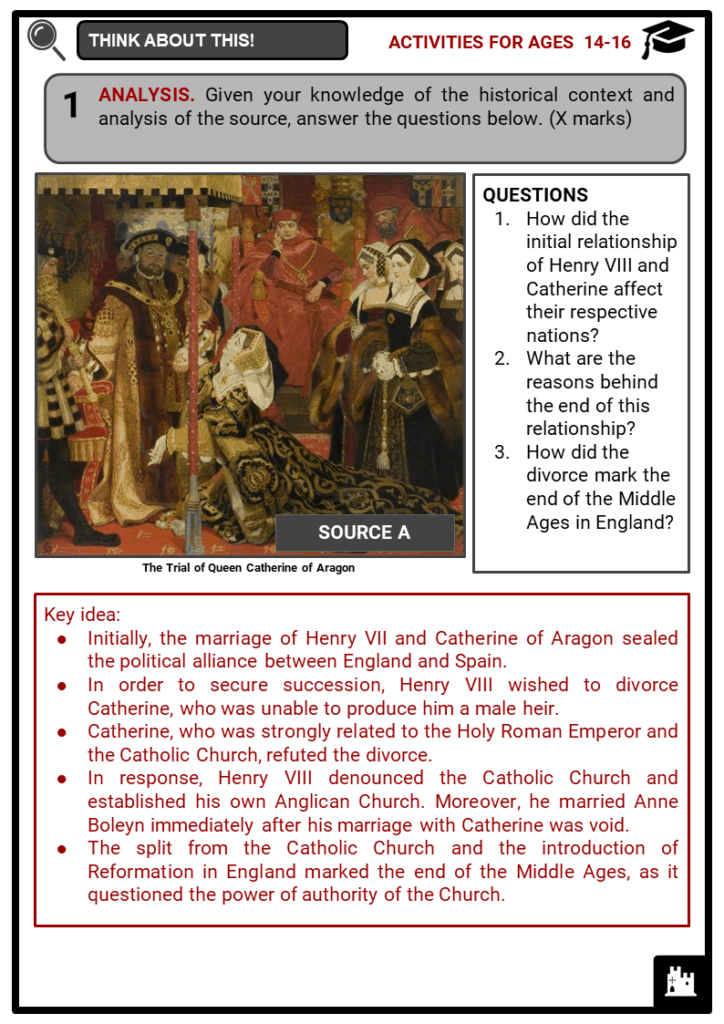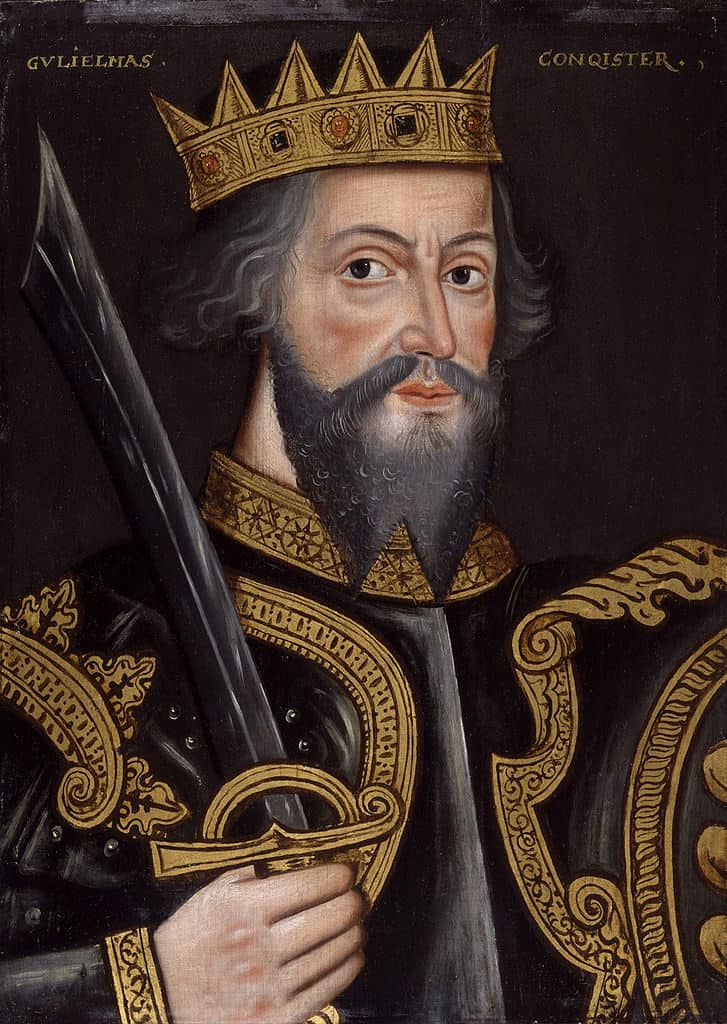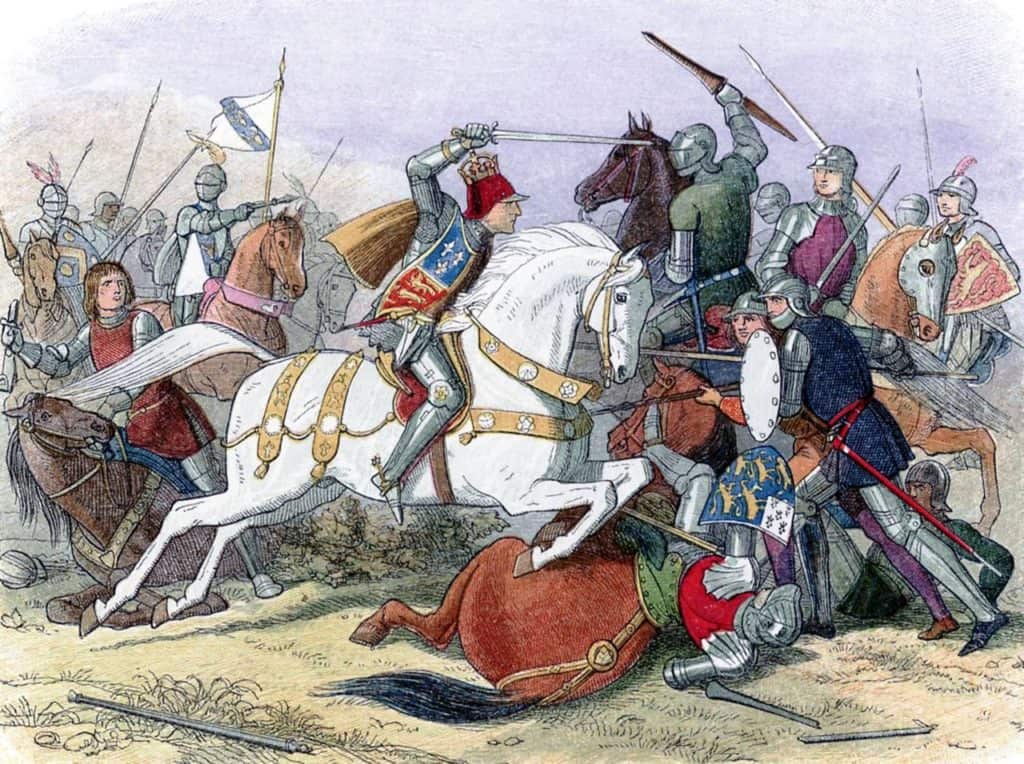Download History of Medieval England Worksheets
Do you want to save dozens of hours in time? Get your evenings and weekends back? Be able to teach History of Medieval England to your students?
Our worksheet bundle includes a fact file and printable worksheets and student activities. Perfect for both the classroom and homeschooling!
Table of Contents
Add a header to begin generating the table of contents
Summary
- Brief historical timeline of Medieval England
- Important events in Medieval England divided into three parts: (a) Early, (b) High, and (c) Late Middle Ages.
Key Facts And Information
Let’s learn more about Medieval England!
- The English Middle Ages is a historical period that started in the 5th century and ended in the 16th century. Historically, it begins with the departure of the Roman legions from Britain and the invasion of the Anglo-Saxons. It then ends with Henry VIII and the reform of the Scottish theologian, John Knox. The 5th century is known by historians as the ‘sub-Roman period’ or ‘dark ages’, and the 6th century is known as the ‘Anglo-Saxon heptarchy’.
- At the end of the 8th century, the Vikings arrived in Britain, causing many changes on the island. The Norman conquest ended the period of Anglo-Saxon England.
Timeline of Medieval England
Early Middle Ages: Anglo-Saxon Heptarchy
- The Romans left England around 410 AD, and the people that lived north of Hadrian’s Wall (the Picts, Scotti, and Caledonians) began to move into the island’s fertile southern plains. To defend themselves from attacks, the Britons sought help from the Germanic tribes of Europe (the Jutes, Saxons, and Angles). Within a few years, several Germanic kingdoms were created: Kent, Sussex, Wessex, Essex, Northumbria, and East Anglia. The Britons created a myriad of kingdoms and defended themselves tenaciously.
- Between 650 and 800 AD, Anglo-Saxon kingdoms were established with constant threat from rival kings.
- Settled by the Jutes, Kent was probably formed from at least two smaller kingdoms. With Ethelbert as king, Kent became one of the wealthiest kingdoms in southern Britain. At the time of Ethelbert’s reign, laws of Kent were written down as charters to be implemented.
- With the establishment of Canterbury by Augustine, subjects like poetry, astronomy, mathematics, and Greek were taught, making it a major intellectual center. Similar to Kent, other kingdoms began to emerge.
- East Anglia was inhabited by the Angles: the North Folk (living in modern Norfolk), and the South Folk (living in Suffolk). It was known for its wealth, and under the influence of the King of Kent, East Anglia was converted to Christianity.
- In the north, Northumbria became the most powerful kingdom. It was formed from the smaller kingdoms of Bernicia and Deira. With its strong cultural connection with Ireland and Rome, Northumbria emerged as the most influential Anglo-Saxon kingdom.
- When Mercia gained power in the 700s, Northumbria’s dominance declined. In the 7th century, Penda, a Mercian king who refused to convert to Christianity, defeated two Northumbrian kings. During the reign of Penda, Mercia accumulated enormous wealth and military power.
- At one point in time, Kent, Mercia, and East Anglia were ruled by one king, Ethelbald, who became known as the King of South English. Succeeded by King Offa, Mercia extended its power and seized London, East Anglia, and Kent. With the death of King Offa, the Pope deposed the late king’s son and abolished the archbishopric of Lichfield (it had replaced the archbishop of Canterbury). By the 800s, East Anglia was freed from Mercian control.
- In 825 AD, King Ecgberht of the West Saxons defeated Beornwulf, King of the Mercians, which resulted in the transfer of overlordship of Kent, Sussex, Surrey, and Essex to West Saxon (Wessex).
- Territorial gains under King Ethelwulf were further sealed with the marriage alliance to a Frankish princess who was the great granddaughter of Charlemagne.
Early Middle Ages: The Viking Age
- The Viking Age in Britain began with the raids in June 793 AD at the abbey of Lindisfarne. That was followed by the sacking of the monastery of Jarrow in Northumbria in 794 AD and Iona, Scotland, in 795 AD. Viking raids continued until 1066 AD with the invasion of Harald Hardrada, the Norwegian King who became known as the ‘last of the Vikings’.
- Lindisfarne Priory became the first victim of raids by the Vikings due to its coastline location. Founded in 635 AD, the monastery was among the most important pilgrimage sites in the area.
- Since the landing in Norfolk in 787 AD, the Norse raiders plundered British territories from time to time. Among the weakest and most frequent targets were monasteries and abbeys, which later labelled the raiders as ‘heathens’.
- By 873 AD, the kingdom of Mercia completely fell to the Vikings. After eight years of raiding England, the Heathen Army split in half. Halfdan Ragnarsson conquered the north, while the other half moved south.
- As Halfdan conquered the north, his army began to plow land and establish farms. In the south, his brother, Guthrum, faced a series of battles against King Alfred.
- At the Battle of Edington, the Anglo-Saxons were victorious against the Vikings. As a result, Wessex became the only kingdom free from the Vikings. After his defeat, Guthrum agreed to be baptized.
- Given the success of the Viking expansion in the 9th century, the Danelaw, which refers to the lands to the north and east of England, was conquered by the invaders.
- Under the Danelaw, five fortified towns, known as the Five Boroughs, were established: Leicester, Nottingham, Derby, Stamford, and Lincoln. These five towns under the control of the Vikings followed Danish law and customs.
- A total of fifteen shires were included in the Danelaw: Leicester, Nottingham, Derby, Lincoln, York, Essex, Cambridge, Suffolk, Northampton, Norfolk, Huntington, Bedford, Middlesex, Hertford, and Buckinghamshire.
- A Danish Jarldom ruled each borough, controlling the lands and answering to a Jorvik, or overlord, in the Viking Kingdom of York.
- By 942 AD, King Edmund recovered the Five Boroughs from the Vikings.
- For some time, the Danelaw established civilian peace between the neighboring Anglo-Saxon and Viking communities.
- As a result of this co-existence, many Norse words were mixed into the English language.
High Middle Ages: Norman Invasion
- The term ‘Borough’ came from the Old English word burg, which means “walled” or “fortified”.
- Originally called the north-men, the Normans were people of Scandinavia who inhabited Normandy, which is in northern present-day France. Like the Anglo-Saxons, the Normans were Scandinavian immigrants who settled in parts of Europe, specifically England.
- The main reason behind the Norman conquest of England was Duke William of Normandy’s claim to the English throne as promised by Edward the Confessor. When Edward, the last king of Wessex, died in 1066 AD, Harold Godwinson, his brother-in-law, succeeded him on the throne. This was contested by Harald Hardrada, King of Norway, and William, Duke of Normandy.
- Links of Norman and English Kingdoms
- HAROLD GODWINSON
- Harold was the Earl of Wessex and Edward the Confessor’s brother-in-law. While not a member of the royal family, Harold was equipped with military success and political influence. On January 6, after the death of Edward the Confessor, he was crowned King of England. While Edward was on his deathbed, Harold was nominated as the king’s successor, as the king was childless.
- HARALD HARDRADA
- In 1046, Harald succeeded Magnus I as King of Norway. During the reign of Magnus, Harthacnut, who was King of England, promised Magnus the Kingdom of Denmark. As part of the late king’s legacy, Harald attempted to claim Denmark. With its failure in 1064 AD, he tried to invade England in 1066 AD. This decision cost him his life.
- WILLIAM DUKE OF NORMANDY
- Later known as William the Conqueror, the Duke of Normandy claimed the throne of England after an alleged promise from Edward in 1051. William was a distant cousin of Edward on his mother’s side.
- Battle of Hastings and Kingship of William I
- On September 28, 1066, William and his troops landed at Pevensey, England. After seizing England’s southeast coast, they marched to Hastings.
- On October 14, 1066, King Harold positioned his exhausted army on Senlac Hill near Hastings. The battle ended in a decisive Norman victory. According to legend, King Harold was said to have been shot in the eye with an arrow.
- By Christmas of the same year, William reached London and was crowned as the first Norman King of England. His invasion of England led to the end of the Anglo-Saxon era of English history and the beginning of French influence in the kingdom.
- In order to successfully carry out the conquest, William had to ensure that opposition to his rule was removed.
- To do this, William encouraged people to support him or powerfully deter opponents from acting.
- William’s approach to government was key in order to secure both his position as king and the inheritance of his heirs.
- In December, Edgar and many of the English nobles travelled to Berkhamsted and swore loyalty to William. This is known as the Submission of the Earls.
- William also attempted to secure the support of the English lords through marriage alliances. Earl Waltheof married William’s niece, and discussions were had about a possible marriage between Earl Edwin and one of William’s daughters.
- William dealt harshly with descendants of those who had died at Hastings, taking away their land and refusing to allow heirs to inherit their titles. This allowed William to give their land and titles to Normans instead, meaning that some of the most powerful people in England were Normans whom William could rely on to support him.
- Building of castles
- Castles were vitally important to William in allowing him to take control of England after the Battle of Hastings. Despite being fairly simple constructions, the motte-and-bailey castles that were established meant that potentially rebellious Anglo-Saxons were presented with a powerful symbol of Norman strength and authority.
- If a rebellion were to occur, the castles built by William also gave protection to the Norman soldiers within.
- Land surveying and the Domesday Book
- As king of England, William I ordered the surveying of all English lands and holdings. In December 1085, as commissioned by the new king, wealth and assets throughout England were assessed by the Royal commissioners in order to raise taxes and pay the army.
- In 1086, the Domesday Book was first published, containing records for 13,418 settlements located south of the Ribble and Tees rivers. England was then divided into 7 regions called circuits.
- 3 to 4 commissioners were sent out to question a jury of barons and villagers. In addition to land assets, records of cows, pigs, and fish were recorded.
- The title ‘Domesday Book’ was adopted in the late 12th century in reference to the Last Judgement as described in the Christian Bible.
- Introduction of Feudalism
- During his reign, William I modified the existing Anglo-Saxon hierarchical system. The initial move was to claim all land in England. About 20% was retained for his own use, while another 25% went to the church.
- The rest was distributed to about 170 tenants-in-chief, who were called barons. Those barons were the ones who helped him during the Battle of Hastings. Under William’s authority and power, about 6,000 manors in England were distributed.
- When William died, succession problems arose.
- During the weak reign of Stephen I (1135 – 1154 AD), the situation of the English kingdom gradually deteriorated, oscillating between the civil war and the barons’ feudal power.
- This instability was followed by raids of Scottish and Welsh raiders. Stephen also came into conflict with his cousin, Empress Matilda, for dynastic reasons. She invaded England from France in the autumn of 1139 AD, together with her husband, Geoffrey of Anjou, and her half-brother, Robert of Gloucester. Stephen I was captured and his reign came to an end.
- Matilda became queen but entered into conflict with her vassals and was expelled from London. The result was a period of instability and a civil war that ended in 1148 AD when Matilda returned to France.
- Stephen returned to the throne, reigning until his death in 1154 AD. After the death of his heirs, Stephen agreed with Matilda, recognizing her son, Henry of Anjou, the future Henry II, as his successor. His reign marked a return to monarchic centralism (to the detriment of the feudal power of the barons and the legislative power of the Church).
High Middle Ages: The Third Crusade
- The crusading movement was a series of military campaigns against the Muslims in the Middle East. It rooted from the act of pilgrimage supported by the Church’s Gregorian reforms.
- In 1096 AD, in response to the appeal of Emperor Alexius I, Pope Urban II made his speech at the Council of Clermont urging every social class to embark on a righteous war to rescue the Holy Land from the hands of the ‘infidels.’
- Amidst the birth of the crusading movement in 1095 AD, after the call by Pope Urban II, England only actively joined during the Third Crusade, which occured from 1187 until 1192 AD.
- The leaders of the Third Crusade were the Emperor Frederick I Barbarossa of Germany, King Philip Augustus of France, and King Richard the Lionhearted of England. Emperor Frederick was drowned in Asia Minor, and only a few of his men reached the Holy Land.
- The other two leaders arrived with their armies, but since they were rivals in Europe, they soon quarrelled in the Holy Land, as well. Philip Augustus feigned illness and returned to France, scheming to win back the duchy of Normandy from Richard’s control.
- Richard the Lionhearted was then the sole leader of the Third Crusade. His exploits gave rise to the legends of the Lionhearted, and, through these legends, Richard acquired a posthumous prestige far greater than he actually deserved.
- Richard did regain Acre and Jaffa for the Christians, but that was all. The agreement he finally reached with Saladin gave pilgrims free access to Jerusalem and little else.
- The city itself and the adjoining kingdom, except for some coastal cities, were still subject to the same law – that of the Koran, not the Holy Bible.
High Middle Ages: Signing of the Magna Carta
- Richard’s successor and brother, John, lost many territories in France and was unable to cope with the nobles and the Church. Therefore, he was eventually forced to sign the Magna Carta, which imposed major limits on the sovereign’s personal power.
- King John was a very unpopular king. He lived in the shadow of his brother, Richard the Lionhearted. He attempted to take the throne while Richard was on the Third Crusade but was excommunicated. He was often seen at loggerheads with his bishops and barons. Ultimately, his fiscal policies upset his barons to the point that they revolted.
- In 1199 AD, John became king after his brother, Richard I, died. John had land in Normandy, France, which he lost in 1204 AD. He spent much of his 17-year reign trying to win it back, which was exorbitantly expensive and came at the cost of losing his own friends and allies.
- John took full advantage of a tax called SCUTAGE. This was a tax paid to the king by wealthy nobility, such as barons and knights, to avoid fighting in the army. John asked for scutage 11 times between 1199 and 1214 AD and increased the amount each time.
- The barons had different motives during the negotiations with King John at the Runnymede, Surrey. This eventually led to the enforcement of the Magna Carta on June 15, 1215.
- The Magna Carta has 63 clauses, most of which were related to 13th-century life, but there were 10 that were particularly important.
- King John’s son, Henry III, ascended the throne at just 9 years old. His kingdom was characterised by many revolts and civil wars, often caused by the incompetence and bad government of the central power.
Late Middle Ages: Hundred Years’ War
- Historians adopted the term "Hundred Years' War" as a means to periodize all the events that culminated in the longest military conflict in European history (1337 to 1453).
- The conflict drew in many allies of the English House of Plantagenet against the French House of Valois over the right to rule the kingdom of France and the issue of sovereignty.
- The Hundred Years’ War was divided into three phases:
- The Edwardian Era War (1337-60)
- The Caroline War (1369-1389)
- The Lancastrian War (1415-1453)
- The war was between the English House of Plantagenet and the French House of Valois.
- The battle spanned five generations of kings and two rival dynasties over the largest kingdom in Western Europe.
- French kings technically held the advantage over England with more money, more military resources, more people, and larger territory.
- The English army under Edward III was well disciplined and used longbows to stop French cavalry.
- Edward III won the Battle of Sluys in 1340 AD, which gained England control of the Channel.
- Edward III’s son, the Black Prince, won significant victories at Crécy (1346 AD) and captured Calais. He then won at Poitiers (1356 AD).
- Philip VI died and was replaced by King John II (1350 AD), who was captured by the Black Prince at Poitiers.
- In 1359 AD, the captive King John II of France was forced to accept the Treaty of London.
- The treaty handed over too much territory (almost ⅓ of France) to England, and the estates rejected it.
- Edward invaded again but was weak, so he negotiated the Treaty of Brétigny. France agreed to these terms.
- John II died in England and was succeeded by Charles V.
- The Black Prince died before becoming king of England. His son acceded when his grandfather, Edward III, died a year later (1377 AD).
Late Middle Ages: The Black Death
- The Black Death was a devastating pandemic of bubonic plague that arrived in Europe in October of 1347. This pandemic killed millions of people. War, famine, and weather contributed to its severity.
- The Black Death halted conflict of the Edwardian Era War and threw England and France’s economies into turmoil. It weakened the Church’s power and caused social upheavals with significant impact on the course of world history, especially European history.
- By 1348, the Black Death arrived in England through Bristol, one of the busiest ports in Europe.
- By the time the plague reached Bristol, London was inhabited by around 70,000 people.
- According to historians, poor hygiene and living conditions in London led to the spread of the plague to the rest of England. The River Thames, in particular, carried infections through ships. The Church recorded about 20,000 deaths in London between 1348 and 1350 AD.
- On September 2, 1348, Joan Plantagenet, daughter of King Edward III of England, died of the plague. Joan, who was arranged to be married to King Pedro of Castile, died in Bordeaux, Aquitaine, France. In two years, the plague killed 30-40% of the English population. The Black Death literally wiped out entire villages and towns.
- The plague easily flourished in London, given the foul conditions of the city. People usually emptied their chamber pots out of the window, straight onto the streets. Moreover, many residents owned pigs inside their homes that were often scrounging in the streets for food.
- Cities were strikingly filthy and infested with lice, fleas, and rats. Narrow streets, open sewage, and dense housing that was overcrowded with poor ventilation, along with malnutrition and poor hygiene facilitated the spread of the plague. All social classes were affected, although the lower classes, living together in unhealthy places, were most vulnerable.
- Within eighteen months of the plague reaching London, about 400,000 people had perished. As expected, they were buried in mass graves, especially those who were poor. With the increasing death toll, the Smithfield cemetery was hurriedly opened by the Bishop of London. In addition, a secondary cemetery was opened at Spittle Croft.
- The same year, Edward III ordered cleaning of the streets of London to further avoid contamination. However, the council replied that street sweepers and cleaners had died of the plague.
Late Middle Ages: Wars of the Roses
- As the Wars of the Roses between the houses of Lancaster and York drew to a close, Margaret Beaufort came to have the only surviving Lancastrian claim to the throne. The son of her marriage to Edmund Tudor mounted the throne as Henry VII.
- In the beginning of the 10th century, the House of Plantagenet from the cadet branch of the counts of Anjou was established. This dynastic family ruled England for over three centuries, from 1154 until 1485 AD. This family provided the kingdom with 14 of its sovereigns.
- Henry II, son of Geoffrey Count of Anjou, became the first Plantagenet king of England. This dynasty is usually subdivided into three parts:
- In 1399 AD, the dispute between the Houses of Lancaster and York began when Henry IV made his cousin Richard II abdicate the throne and made himself king. After the death of his father in 1413 AD, Henry V ascended the throne.
- The House of Lancaster
- Signified by a red rose during the Wars of the Roses, the royal House of Lancaster was founded in 1267 AD, when King Henry III of England created the Earldom of Lancaster for his second son Edmund Crouchback. Under this house, three Henrys (IV, V, and VI) ruled as king of England between 1399 and 1471 AD.
- The House of York
- Founded by Edmund Langley, King Edward III’s fifth son, the royal House of York was the younger branch of the Plantagenet House. It provided England with three kings - Edward IV, Edward V, and Richard III, before finally handing England to the Tudor Dynasty.
- After defeating the Lancastrians in a number of battles, Edward IV became the first Yorkist king of England in 1461 AD. By overthrowing Lancastrian king, Henry VI, Edward reigned as king until 1470 AD.
- For a year, Henry VI was able to restore his kingship. By 1471 AD, Edward IV became king again and was later succeeded by his eldest son, Edward V. After two months of being king, he was deposed by his own uncle, Richard III. For two years, Richard III ruled as king of England until his death at the Battle of Bosworth against future Tudor King, Henry VII.
- Unification under the House of Tudor
- Henry VII was the first Tudor king of England. He was born in Pembroke Castle in Wales, on January 28, 1457. Through his mother, he could trace his descent from John of Gaunt, son of Edward III. In 1471 AD, he was taken to Brittany by his uncle, Jasper Tudor, to protect him from the victorious Yorkists led by Edward IV.
- Trying to enforce his claim to the throne, Henry’s attempted invasion of England in 1483 AD failed, but in 1485, he defeated and killed Richard III at the battle of Bosworth.
- He married his daughter, Margaret, to James IV, king of Scotland. He also married his son to Catherine of Aragon, thereby gaining increased recognition of his new dynasty.
- The royal House of Tudor
- The emergence of the Tudor Dynasty marked the end of the war between the royal houses of Lancaster and York.
Henry VIII and the End of the Medieval Period in England
- Born in Greenwich in 1491 AD, Henry was the second son of Henry VII. The death of his eldest son, Arthur, in 1502 AD, made Henry the heir to the English throne, which he ascended to in 1509 AD. Soon after his ascension, he married Catherine of Aragon, his brother’s widow. Between 1510-1514 AD, Henry was involved in the war between France and Spain. Between 1512-1513 AD, he took part in the war between France and Scotland.
- The war gave Henry his first great minister, Cardinal Thomas Wolsey. Starting in 1515 AD, Wolsey held all the strings of power in state and church. Henry never lost ultimate control of affairs, but he was content to follow Wolsey’s lead.
- Meanwhile, by 1527 AD, Henry was determined to get rid of his wife. His chief motives were a passionate attachment to one of the court ladies, Anne Boleyn, and his fear for the succession.
- A marriage annulment was not easy to obtain under the Catholic Church. In fact, Cardinal Thomas Wolsey attempted to gain the Pope’s permission for divorce. However, Catherine did not want to divorce her husband, and, thanks to the ‘speech of her life’, the Pope did not grant the annulment.
- As a consequence, Thomas Cromwell took the lead and suggested the king break with the Church of Rome and become the head of the Church of England through the Act of Supremacy (1534). Thanks to Cromwell’s intervention, Henry VIII managed to divorce Catherine of Aragon. They had been married for over twenty years.
- Henry divorced from Catherine. Such resolution caused the dissolution of monasteries and promoted the rise of Protestantism. However, difficulties over what was the true faith ended with the adoption of the orthodox Act of Six Articles (1539) and a careful holding of the balance between extreme factions after 1540 AD.
- Meanwhile, even in Scotland, the Church was hit by the Protestant Reformation with John Knox. These two events marked the end of the English Middle Ages.
Image sources:
[3.] https://upload.wikimedia.org/wikipedia/commons/4/40/Battle_of_Bosworth_by_James_Doyle.jpg

